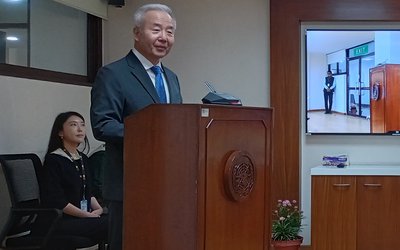More on National






Janaki Singh, 21, mother of two, died on the way to district hospital in Chainpur of Bajahng district a month ago due to physiological difficulties during her delivery. Shahi is among hundreds of Nepalis women, still uncertain to survive in the time of delivery.
Kanchi Tamang,19, a resident of Narayansthan Health Center in Kavre district, had to see abortion after two and a half months. Tamang, who has already a two-year daughter, got pregnancy due to unavailability of contraceptives of her choice. “I came here several times for Norplant, but it was not available here. Had I got Norplant, I would not have been pregnant.”
These two cases are incidents which tell about the state of Reproductive Health and Family planning in Nepal. Although the maternal mortality rate has drastically declined giving Nepal the chance to be one of the countries to meet the MDG target 5 and due to increase of awareness of adolescents on the issue related to reproductive health and family planning methods, Nepal still needs to do more to improve infrastructures and improve the supply of all kinds of family planning methods. As a number of people have still a limited choice on family planning methods, the achievement Nepal has made in population management is still uncertain.
As Nepal has been facing a tough situation, government policymakers, civil society leaders, experts, former parliamentarians, politicians and youth discussed recently on the agenda of Reproductive Health and Family Planning urging government to improve the quality and coverage of reproductive health and family planning service including the contraceptives.
In a National Consultation of Policy Makers, former members of parliament, political leaders and Civil Society leaders on Reproductive Health and Family Planning Beyond 2014, speakers stress the need to address the demand of adolescents and young people aged 10-24 years with young females aged 10-24 accounting 10 percent the total population.
The consultation assessed achievements made and gaps and challenges remaining in the area of RH and Family Planning in Nepal nearly two decades after the International Conference on Population and Development (ICPD) which was held in Cairo in 1994.
Organized by the International Council on Management of Population Programs (ICOMP) and the Central Department of Population Studies (CDPS) of Tribhuvan University with support of Packard Foundation, the two day consultation concluded on May 18 in Dhulikhel, 30 kilometers east of capital. The consultations was first of its kind program to facilitate country level dialogue amongst policy-makers, civil society leaders and other relevant stakeholders to identify the critical gaps and challenges as well as lessons learned since the implementation of the 1994 (ICPD) Plan of Action.
The consultation concluded that Nepal has achieved remarkable reduction in maternal mortality from 539 in 1996 to 229 in 2009; and also a decline in total fertility rate from 4.6 in 1996 to 2.6 in 2011, many challenges still remain in meeting the needs of information and services for the people, particularly the young people of Nepal.
The consultation concluded with a summary outcome document which highlighted the priority actions needed in the coming years to meet the sexual and reproductive health needs and rights of women, men and young people living in rural parts of Nepal.
“I am very pleased to say that the national consultation facilitated country level dialogue amongst the policy makers and civil society leaders and other relevant stake holders to identify the critical gaps and challenges as well as lessons learned since the implementation of the 1994 ICPD Plan of Action,” said Dr.Wasim Zaman, executive director, ICOMP.
Nepal is very close to reaching its MDG Goal 5 on reducing maternal mortality and infant mortality by 2015, but much more needs to be done to continue progressing, given there are still too many women who deliver at home, often in difficult conditions and without skilled assistance. Similarly, there is huge supply gap on family planning to the adolescents and youth.
“All women of reproductive age are yet to have access to contraception to avoid unintended pregnancies and all pregnant women do not have access to skilled care during pregnancy and after child birth. And those with complications need to have timely access to quality emergency obstetric care,” said Shofica Regmi, 20, a youth participant.
Government is expanding the facilities to meet the need. “It is true that currently only one in three births is attended by a skilled birth attendant in Nepal and a full range of contraceptives are not widely available and accessible. The Ministry of Health and Population is now working to strengthen the referral system to deal with complicated births,” said Dr. Badri Pokharel, joint secretary and chief of Population Division of Ministry of Health and Population.
The experiences have shown that universal access to family planning can reduce maternal deaths as well as improve the quality of life of infants. “It is essential to help every young person, woman and couple to decide freely when and how many children they want. Family Planning Association of Nepal has been working with adolescents and youths in different parts of the country to improve the situation,” said Dr. Navin N.P. Thapa, director, Resource Mobilization and External International Affairs of Family Planning Association of Nepal in the consultation.
One of the objectives of the workshop was to conduct dialogue on the issue to be raised and critical messages to be taken to the regional level reviews in preparation for the UNGASS on ICPD beyond 2014. It also helped to promote strong partnership amongst elected leaders, policy-makers, civil society leaders and national/international development partners in dealing with the issues of ICPD beyond 2014.
Stakeholders agreed on the critical gaps, challenges and opportunities for the country. “Population has linkages with different sectors of economy, culture and development. There is the need to strongly show the linkage between reproductive health and education,” said former secretary Balananda Poudel, who was at several ministries including Education, Women, Children and Social Welfare. “Improving quality and coverage of RH & FP information and services are important. There need is responding to the unique needs of young people including RH needs.”
Political leaders agree on the need to strengthening community engagement and demand for family planning services. “Strengthening partnerships and collaboration with community and approaching all programs with Gender Equality and Equity along with Inclusion of poor, disadvantaged and Marginal Populations are essential,” said Chitra Lekha Yadav, former deputy speaker of Parliament and treasurer of Nepali Congress. “The discussions held at the consultation meeting covered wide areas related to RH and Family Planning.
Ananda Tamang, Executive Director of CREPHA presented the situation analysis of Reproductive Health and Family Planning, reviewing its successes, changing needs and challenges. “There is the need to increase and mobilize skilled human resources and enhance adolescents-friendly Reproductive Health and Family Planning Services.”
Similarly, Dr. Ram Hari Aryal, member of governing council of PAN, also presented a paper on unmet needs of family planning in Nepal and its implications. “We have already discussed the issue. The time has come now to increase quality of services to meet the needs of the rural people,” said former member of Constituent assembly Aang Dawa Sherpa.
Nepal has 0.29 health workers for every 1,000 people, a small fraction of the World Health Organization recommended 2.3 needed to offer basic lifesaving care, including vaccinations for every 1,000 residents. Despite achievements, the quality of service and number of health personnel. A 2011-2015 government health human resources plan pinpointed this disparity; in the last decade the population grew by 45 percent while public health staffing increased by only 3 percent.
And while the private sector has expanded significantly, those facilities are mostly in urban areas (in a country where some 80 percent of the population lives in rural areas) and are unaffordable to the poor. Family planning access is still out of reach for youths. Twenty-seven percent of married women nationwide have an unmet need for family planning, increasing to 42 percent if only counting women aged 15-19 - significant given half of all females in Nepal are married by age 18.
“Indeed, the ICPD Beyond 2014 Review was an opportunity for all of us to renew our collective commitment to address the remaining gaps in the implementation of the ICPD, PoA, and to address new and emerging challenges and opportunities in the nexus between population and sustainable development. This national consultation workshop with our former parliamentarians, CSO representatives, academia, researchers, media and other development partners, which is focusing on looking at reproductive health and family planning beyond 2014, is befitting the very core of what UNFPA believes the next ICPD priorities should be for developing countries like Nepal,” said Bijay Thapa, Assistant Representative, UNFPA
"Yes, inequities do persist in Nepal. Between rich and poor; between educated and uneducated; between urban and rural; between advantaged and disadvantaged groups. Unless we address these inequities effectively in access and utilization by those who are lagging behind of quality sexual and reproductive health care and family planning services, we will not achieve our MDG 5a and b targets by 2015,”said Thapa, Assistant Representative, UNFPA .
At a time when Nepal government is preparing for ICPD+20, national consultation with policy makers and civil society leaders on reproductive health and Family planning, the outcome of the consultation provided inputs for Nepal's participation in the regional and global meetings that are taking place leading up to the Special Session of UN General Assembly to take place in 2014 to chart regional and global actions for Population and Development in 2015 and beyond.







